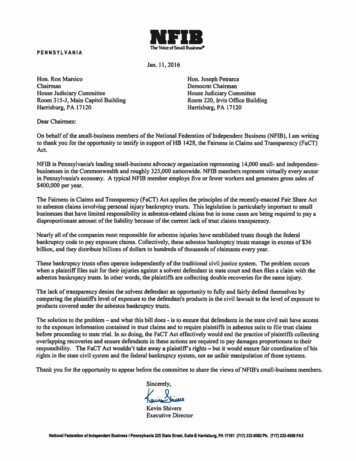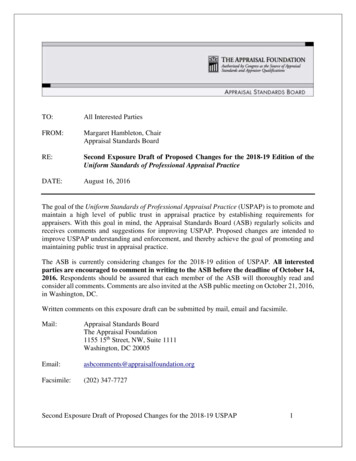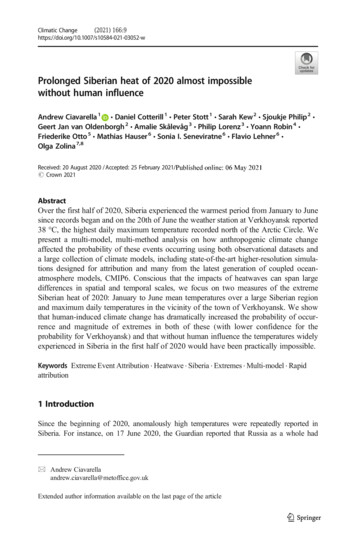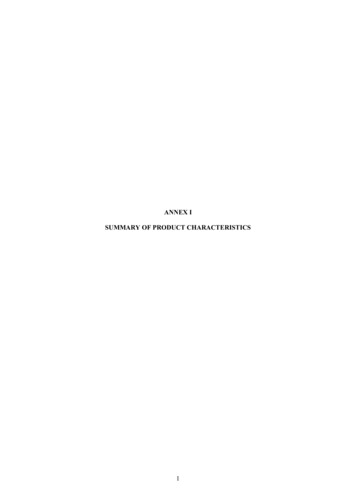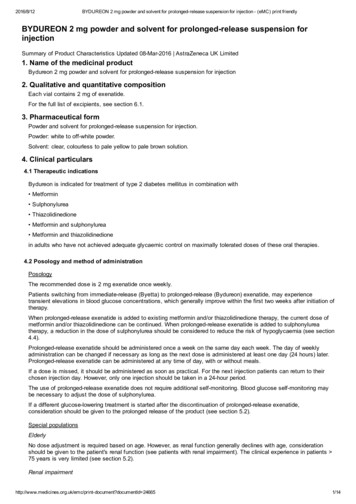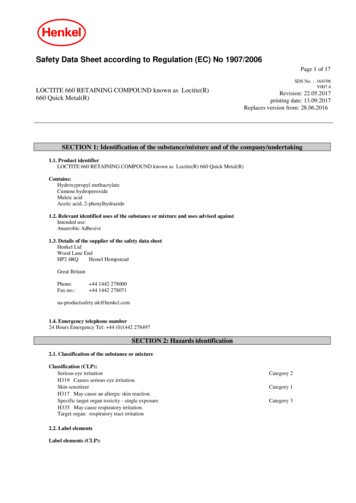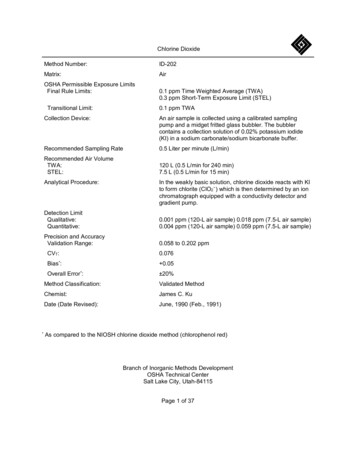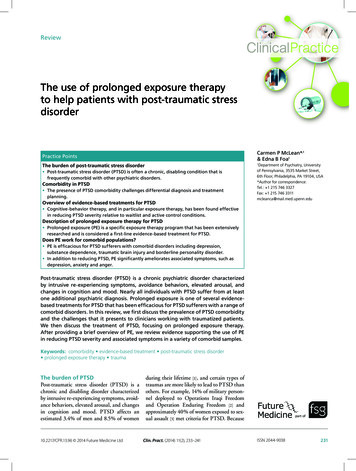
Transcription
ReviewThe use of prolonged exposure therapyto help patients with post-traumatic stressdisorderCarmen P McLean*,1& Edna B Foa1Practice PointsThe burden of post-traumatic stress disorder Post-traumatic stress disorder (PTSD) is often a chronic, disabling condition that isfrequently comorbid with other psychiatric disorders.Comorbidity in PTSD The presence of PTSD comorbidity challenges differential diagnosis and treatmentplanning.Overview of evidence-based treatments for PTSD1Department of Psychiatry, Universityof Pennsylvania, 3535 Market Street,6th Floor, Philadelphia, PA 19104, USA*Author for correspondence:Tel.: 1 215 746 3327Fax: 1 215 746 3311mcleanca@ mail.med.upenn.edu Cognitive-behavior therapy, and in particular exposure therapy, has been found effectivein reducing PTSD severity relative to waitlist and active control conditions.Description of prolonged exposure therapy for PTSD Prolonged exposure (PE) is a specific exposure therapy program that has been extensivelyresearched and is considered a first-line evidence-based treatment for PTSD.Does PE work for comorbid populations? PE is efficacious for PTSD sufferers with comorbid disorders including depression,substance dependence, traumatic brain injury and borderline personality disorder. In addition to reducing PTSD, PE significantly ameliorates associated symptoms, such asdepression, anxiety and anger.Post-traumatic stress disorder (PTSD) is a chronic psychiatric disorder character izedby intrusive re-experiencing symptoms, avoidance behaviors, elevated arousal, andchanges in cognition and mood. Nearly all individuals with PTSD suffer from at leastone additional psychiatric diagnosis. Prolonged exposure is one of several evidencebased treatments for PTSD that has been efficacious for PTSD sufferers with a range ofcomorbid disorders. In this review, we first discuss the prevalence of PTSD comorbidityand the challenges that it presents to clinicians working with traumatized patients.We then discuss the treatment of PTSD, focusing on prolonged exposure therapy.After providing a brief overview of PE, we review evidence supporting the use of PEin reducing PTSD severity and associated symptoms in a variety of comorbid samples.Keywords: comorbidity evidence-based treatment post-traumatic stress disorder prolonged exposure therapy traumaThe burden of PTSDPost-traumatic stress disorder (PTSD) is achronic and disabling disorder characterizedby intrusive re-experiencing symptoms, avoidance behaviors, elevated arousal, and changesin cognition and mood. PTSD affects anestimated 3.4% of men and 8.5% of women10.2217/CPR.13.96 2014 Future Medicine Ltdduring their lifetime [1] , and certain types oftraumas are more likely to lead to PTSD thanothers. For example, 14% of military personnel deployed to Operations Iraqi Freedomand Operation Enduring Freedom [2] andapproximately 40% of women exposed to sexual assault [3] met criteria for PTSD. BecauseClin. Pract. (2014) 11(2), 233–241part ofISSN 2044-9038231
ReviewMcLean & FoaPTSD is comprised of a large range of symptoms, it cancause dysfunction across multiple areas. Without effective treatment, after 1 year PTSD typically becomeschronic, debilitating, and associated with significantdistress and overall functional impairment [4] . Moreover, most individuals with PTSD suffer from at leastone additional psychiatric diagnosis [5] . For example,major depressive disorder (MDD), anxiety disordersand substance use disorders all frequently co-occur withPTSD. This high prevalence of comorbidity greatlyimpacts both the clinical presentation and treatment ofPTSD. Therefore, in order to help patients overcomePTSD, it is imperative that treatment addresses thehigh level of comorbidity seen in this population.Comorbidity in PTSDAs noted above, comorbidity of PTSD with other psychiatric disorders is the rule rather than the exception.Epidemiological studies have found that 59% of menand 44% of women with PTSD meet criteria for atleast three psychiatric disorders [5] . In a study of community outpatients, PTSD showed a more severe anddiverse pattern of comorbidity than any other anxiety or mood disorder [6] . One of the most frequentlycomorbid disorders associated with PTSD is MDD.Between 48% and 77% of all PTSD sufferers alsomeet criteria for MDD [5–6] . PTSD often co-occurswith substance use disorders, with rates of PTSD estimated to be at least twice as high among individualswith alcohol dependence compared with the generalpopulation [7] . Other anxiety disorders, particularlygeneralized anxiety disorder (GAD), are also highlyprevalent among individuals with PTSD [6] . In addition, PTSD is associated with elevated rates of physicalhealth problems, including circulatory, digestive, musculoskeletal, nervous system and respiratory disorders[8–10] . Personality disorders such as borderline and antisocial personality disorder are more common amongindividuals with PTSD compared with those withoutPTSD [11,12] .The high level of psychiatric and medical comorbidity among individuals with PTSD presents a significantchallenge to arrive at an accurate diagnosis. There aremany PTSD symptoms that overlap with those of frequently co-occurring disorders. For example, diminished interest in activities may be present in both PTSDand MDD. Similarly, irritability is common to PTSDand GAD. Difficulty sleeping and concentration problems are symptoms of PTSD, MDD and GAD. Panicattacks are characteristic of panic disorder but mayalso be present in individuals with PTSD. This highdegree of symptom overlap between PTSD and comorbid conditions is especially problematic because PTSDhas a heterogeneous presentation with many different232Clin. Pract. (2014) 11(2)symptom constellations. This, combined with the factthat individuals are often reluctant to volunteer information about traumatic experiences, increases the riskthat a PTSD diagnosis is missed. Since an accuratediagnosis of PTSD is necessary to ensure an appropriate treatment program is initiated that will help thepatient overcome the disorder, it important that clinicians conduct a thorough assessment that includesscreening for traumatic events.In addition to making differential diagnosis morechallenging, PTSD comorbidity may complicate treatment. PTSD comorbidity is associated with moresevere clinical impairment, lower quality of life [13–15]and poorer treatment prognosis [16–18] . Although a largenumber of studies find that certain psychosocial treatments are efficacious in reducing PTSD severity, fewerstudies have examined the effect of treatment on comorbid conditions. Clinicians should select treatments thatdemonstrated efficacy in ameliorating PTSD amongdiverse populations, including those with comorbidconditions. Ideally, clinicians would implement treatments that reduce the symptoms of PTSD as well assymptoms of commonly comorbid conditions.Overview of evidence-based treatments forPTSDCognitive–behavior therapy (CBT) refers to a family of treatment approaches and includes exposuretherapy, cognitive therapy and anxiety management.CBT has been deemed the treatment approach ofchoice in clinical practice guidelines for PTSD [19–22] .Several CBTs for PTSD have received empirical support, including prolonged exposure (PE) [23] , cognitiveprocessing therapy (CPT) [24] , cognitive therapy [25]and stress-inoculation therapy (SIT) [26] . Eye movement desensitization retraining (EMDR) has alsobeen found efficacious for PTSD [27] . PE, which wasdeveloped by the second author, has been examinedin the largest number of empirical studies in independent research centers. It is for this reason that we focusour review on PE, while acknowledging that there areseveral other psychotherapies that have demonstratedefficacy treating PTSD.Description of PE therapy for PTSDPE is a manualized exposure therapy program thatinvolves three main components: In vivo exposure to trauma reminders, typicallycompleted as between-session assignments; Imaginal exposure to the memory of the traumaticevent, completed during and between sessions; Processing of imaginal exposure.future science group
The use of prolonged exposure therapy to help patients with PTSDThere are two additional minor components: Psychoeducation about the nature of trauma andtrauma reactions; Training in slow diaphragmic breathing.PE typically consists of eight to 15 individual 90-minsessions delivered once or twice weekly.Therapy begins with the clinician providing a rationale for exposure therapy. The therapist explains thatPTSD symptoms are maintained by two factors: avoidance of thoughts and feelings related to the traumaand avoidance of trauma reminders; and the presenceof unhelpful, distorted beliefs such as “the world isextremely dangerous” and “I am extremely incompetent”. PE alters these negative, distorted perceptions byproviding opportunities for experiential learning (i.e.,exposure) that disconfirms them. In addition, duringthe first session, patients learn a diaphragmatic breathingtechnique that they can use to reduce daily stress.The second session involves a discussion of common reactions to trauma, which provides patientswith a framework for understanding their symptoms.Next, the clinician introduces in vivo exposure, whichrefers to confronting avoided places, people and objectsthat remind the patient of the trauma. The clinicianand patient collaboratively construct a hierarchicallist of safe or low-risk situations that the patient hasbeen avoiding. In vivo exposure is conducted in a stepwise fashion, beginning with situations that provokemoderate anxiety, and gradually progressing to more challenging situations.In session 3, the clinician provides the rationale forimaginal exposure, which is conducted from session 3through to session 10. Imaginal exposure involves asking the patient to confront the memory of his or hertrauma by revisiting it in their imagination and recounting it in detail aloud for approximately 30–45 min. Imaginal exposure is followed by 15–20 min of ‘processing’,in which the clinician and patient discuss thoughts andfeelings about the trauma and about themselves, withthe aim of helping the patient to develop a more realistic and helpful perspective on the event itself and theirbehaviors and emotions during the event. Processing theimaginal exposure allows patients to articulate and integrate new information and insights into their memory.Patients are instructed to listen to an audio recording ofthe imaginal exposure each day as homework.The remaining sessions follow a standard agenda thatbegins with homework review, followed by imaginalexposure and processing, and ending with the assignment of homework exposure exercises for the comingweek. The final session involves reviewing progress,discussing lessons learned, and relapse prevention.future science groupReviewEvidence supporting the use of PENumerous randomized trials indicate that PE iseffective in reducing PTSD symptoms [28] . Exposuretherapy has been found effective for both acute andchronic PTSD [26,29] , and studies show that gainsmade during treatment are maintained at follow-upsof 1–5 years [30,31] . PE has been associated with rapidchange and maintenance of large effect sizes over time[32,33] . Exposure therapy was identified in the joint Veterans Affairs-Department of Defense Clinical PracticeGuideline for PTSD [34] as “strongly recommended”for use with veterans with PTSD. A 2008 report issuedby the Institute of Medicine (IOM) concluded thatexposure therapy was the sole treatment for PTSD withsufficient evidence for its efficacy. This conclusion isconsistent with practice guidelines from the AmericanPsychiatric Association [35] , the Departments of Veterans Affairs and Defense (2004) and the InternationalSociety for Traumatic Stress [36] .PE has been associated with significantly greater preto post-treatment reduction in PTSD symptomatologywhen compared with waitlist [23,26,28,37–40] , supportivecounseling [41,42] , relaxation [33,43–44] and treatment asusual [45–48] . A meta-analysis found that PE was associated with large effect sizes compared with control conditions at post-treatment and at follow-up [49] . Othermeta-analyses that have examined the efficacy of exposure therapy in general have shown that exposure therapy was more effective than waitlist control or supportive therapy [50] , and that exposure therapy is associatedwith a lower dropout rate than pharmacotherapy [51] .Some meta-analyses have found that exposure therapyis more effective than nontrauma-focused treatmentsor waitlist/control at reducing PTSD symptoms, buthave not found significant differences in outcomesamong specific exposure therapies [52–54] . In sum, theevidence in support of the efficacy of exposure therapyin general, and PE specifically, is extensive.Does PE work for comorbid populations?As noted, patients rarely present with PTSD in theabsence of additional psychiatric and physical healthproblems. More often, PTSD sufferers face additional comorbidities such as depression and substanceuse, and associated symptoms such as dissociationand elevated anger. The most useful treatment forPTSD, therefore, is one that demonstrates efficacyamong PTSD sufferers with and without commonly co-occurring disorders.PE has been found effective in reducing PTSDsymptoms among patients with comorbid depression.In a study examining the impact of depression on theefficacy of PE, comorbid depression was found to beunrelated to decrease in PTSD symptoms [55,56] . Thosewww.futuremedicine.com233
ReviewMcLean & Foawith current major depression, past major depressionand no history of major depression all benefitted equallyfrom PE. Interestingly, patients with higher depressionin baseline who received either CPT or PE showedgreater improvement in PTSD symptoms from pre- to post-treatment than those with lower depression [57] .Importantly, PE has not only been found effectiveamong those with PTSD and comorbid depression, butit has also been found to significantly reduce depressivesymptoms in a number of studies [26,38,43,58] . Thus, thepresence of comorbid depression is not a contraindication to PE treatment. However, in cases where majordepression is the primary disorder, or when patients areat a high risk for suicide, therapists must first providecrisis management and containment.Many treatment studies for PTSD have excludedpatients with comorbid substance dependence disorders [23,24] due to concern that substance use willinterfere with patients’ ability to benefit from PTSDtreatment and/or for fear that PTSD treatment willexacerbate substance use. However, studies examining the efficacy of PE with this population have foundpositive results. PE was shown to be effective in reducing PTSD symptoms among patients with PTSD andcomorbid alcohol dependence [59] , and among thosewith comorbid cocaine dependence [60] . PE was notassociated with increased substance use in either of theaforementioned studies. Interestingly, Foa et al. foundthat patients who received PE were also less likely toincrease their drinking 6 months after treatment termination [59] . Thus, PE not only reduces PTSD symptoms in this population, but can also help maintainreductions in drinking behavior.Traumatic brain injury (TBI) is frequently comorbid among PTSD patients, especially active militarypersonnel and veterans, because brain injuries are oftensustained in traumatic experiences. A recent study ofveterans with PTSD found that PE was equally effective in individuals with and without a history of TBI[61] . Regardless of TBI status, veterans with PTSDshowed a significant reduction in PTSD severity posttreatment. Although there is little research on this issueat present, the results of this study provide promisingevidence that PE can be helpful for individuals withPTSD and a history of mild TBI.Patients with PTSD and borderline personalitydisorder (BPD) have also been excluded from sometreatment studies, especially when they report recentintentional self-injury [62–67] . Personality disorders, particularly BPD, have been thought to impede the effectsof treatment of PTSD [68] . However, research suggeststhat individuals with PTSD and comorbid BPD canalso benefit from PTSD treatment. Feeny, Zoellnerand Foa re-analyzed data of patients who received PE,234Clin. Pract. (2014) 11(2)SIT or their combination, and found that women withBPD symptoms benefited as much from treatment asthose without these symptoms [64] . Indeed, patientswith BPD symptoms evidenced significant improvement on PTSD symptoms, PTSD diagnostic status,depression, anxiety and social functioning.Similar results were found in a study that examinedwomen with comorbid BPD and PTSD with recentand/or imminent serious intentional self-injury [69] whoreceived PE concurrently with dialectical behavior therapy (DBT). The results showed that DBT PE resultedin significant reductions in PTSD, and at post-treatment a majority of patients no longer met criteria forPTSD. Importantly, DBT PE did not exacerbate PTSDor BPD symptoms, including self-injurious behavior.The finding that dissociative symptoms did notinterfere with PE contradicts the previously held concern that dissociation would reduce the efficacy ofPTSD treatment by limiting emotional engagement[70,71] . In contrast to Harned et al.’s hypothesis, pretreatment levels of trait dissociation, depersonalization,numbing and depressive symptoms were not related toimprovement or dropout [69] . Patients with high levels of dissociative symptoms showed a similar reduction of PTSD as patients with low levels of dissociativephenomena. In sum, there is no evidence to date that dissociative phenomena predict treatment outcome.PE has also been shown to significantly reduce symptoms that are commonly associated with PTSD. Asnoted above, these include depressive symptoms [26,40]and alcohol use [59] . In addition, PE has been shown tosignificantly reduce general anxiety [23] , trauma-relatedguilt [40] , state-anger [72] , and improves social adjustment and functioning [23] . PE, with or without the addition of cognitive restructuring, has also been shown tosignificantly decrease reported physical health difficulties compared with waitlist, and these improvementspersisted at 12 months post-treatment [73] . In sum, PEcan have a broad impact on the lives of PTSD sufferers by reducing both PTSD severity and a ssociated symptoms, and improving overall f unctioning.Challenges to implementing PEAlthough PE and several other evidence-based treatments have been found effective in significantly reducing symptoms of PTSD and associated problems, it isimportant to note that some patients drop out of treatment or do not achieve a good response. A drop-outrate of approximately 20–30% has been found for bothexposure and nonexposure treatments [74] , and up to40–50% of patients do not achieve a good response [75] ,defined as 70% reduction in symptoms. Research onpredictors of dropout and response is currently lacking.One exception is a study that examined assault-relatedfuture science group
The use of prolonged exposure therapy to help patients with PTSDpredictors of PE, and found that the childhood traumaand trauma that results in sustained physical injuryduring adulthood predicted greater PTSD severity following PE [76] .Like any treatment, there are some contraindicationsto implementing PE. When considering using PE, clinicians should be careful to ensure that: PTSD is theprimary presenting issue; there are no safety issues (i.e.,imminent risk of suicide or homicide, currently knownas self-harm behavior); and there are no comorbid disorders that might interfere with treatment includingunmanaged bipolar disorder or psychosis. That said, asnoted above, most of the commonly occurring comorbidities should not necessarily be considered contraindications to treatment. Concurrent pharmacotherapyshould also not be considered a contraindication to PE,although as a general rule, it is best if medication dosageremains stable during therapy so that the patient andtherapist can accurately gauge the efficacy of therapy.Research on adjuncts to PE has found that addingstress inoculation training (for example, see [26]) andcognitive restructuring [23,43] does not improve outcome compared with PE alone. It has been hypothesized that additional efficacious treatment components fail to improve outcomes because all efficacioustreatments modify the same dysfunctional cognitions underlying PTSD [77] . In other words, despitedifferences at the level of therapy technique, all evidence-based treatments for PTSD may share similarmechanisms of change. Ongoing research examiningstrategies to augment exposure therapy with medications (e.g., d-cycloserine, Methylene Blue) thoughtto boost extinction learning may result in even moree f ficient treatment programs for PTSD.Conclusion & future perspectiveUntreated PTSD is often associated with a host ofadditional problems, including high rates of comorbidconditions such as major depression and substance usedisorders [5] , as well as poor physical health [9,10] and lowquality of life [15] . A number of evidence-based treatments for PTSD have been developed to date and theefficacy of PE has been supported by the greatest number of studies. PE has demonstrated efficacy with a rangeof trauma populations and by multiple research groups(e.g., Israel [78] ; Japan [79] ; Australia [80] ; The Netherlands [81]). Importantly, PE has demonstrated efficacyfor those with PTSD and a number of the commonlycomorbid conditions. On the whole, these studies haveshown that the efficacy of PE in reducing PTSD severityis unhampered by the presence of many comorbid disorders, and it has also been shown to reduce symptomscommonly associated with PTSD such as depression,anxiety and anger. Thus, there is sufficient evidence tofuture science groupReviewconsider PE a first line of treatment for individuals withPTSD and comorbid disorders.In the next 5–10 years, we expect to see continuedgrowth of clinical research that will increase our understanding of how best to treat PTSD across populations.We have already seen encouraging results from studiesexamining PE in comorbid samples and we expect thatthis research will continue to expand the indicationfor evidence-based exposure therapy in new patientpopulations. For example, little is currently knownabout whether modifications are necessary when treating PTSD patients on pain medication for physicalhealth problems. Although there is some evidence thatpatients who are permanently disabled during traumamay require additional therapy to help them adjust totheir limitations [76] , the role of pain medications hasnot been examined. We also expect to see the targetoutcomes broadened to include commonly associatedproblems such as depression and anger, as well as quality of life and functioning. These outcomes are notconsistently described in treatment outcome researchyet are critical to evaluating the potential value of anintervention. Furthermore, we expect that the nextdecade will witness considerable progress in developingstrategies to optimize the efficiency of evidence-basedtreatments such as PE. For example, several studies arenow underway to examine the use of adjunct pharmacological agents that are thought to facilitate extinction learning during exposure therapy. Finally, weexpect that there will be further development in noveltreatment delivery methods that exploit technological advances. Mobile application- and internet-basedtreatments for PTSD have great potential to increasethe cost–effectiveness of treatment and reduce barriers to accessing evidence-based treatment. Currently,most PTSD sufferers do not receive appropriate treatment [4] , in part because there are far too few mentalhealth professionals trained in evidence-based treatments for PTSD (for example, see [82,83]). We hopethat the coming years will witness significant growthin our understanding of effective dissemination andimplementation strategies so that we can better connect evidence-based treatments with those who standto benefit from them.Financial & competing interests disclosureEB Foa receives royalties from Oxford University Press for theProlonged Exposure Therapy treatment manual. The authorshave no other relevant affiliations or financial involvementwith any organization or entity with a financial interest in or financial conflict with the subject matter or materials discussedin the manuscript apart from those disclosed.No writing assistance was utilized in the production of thismanuscript.www.futuremedicine.com235
ReviewMcLean & FoaReferences13Back SE, Sonne SC, Killenn T, Dansky BS, Brady KT.Comparative profiles of women with PTSD and comorbidcocaine or alcohol dependence. Am. J. Drug. Alcohol. Abuse.29(1), 169–189 (2003).14Zatzick DF, Marmar CR, Weiss DS et al. Posttraumaticstress disorder and functioning and quality of life outcomesin a nationally representative sample of male Vietnamveterans. Am. J. Psychiat. 154(12), 1690–1695 (1997).15Zayfert C, Dums A, Ferguson R, Hegel M. Healthfunctioning impairments associated with posttraumatic stressdisorder, anxiety disorders, and depression. J. Nerv. Ment.Dis. 190, 233–240 (2002).16Back S, Dansky BS, Coffey SF, Saladin ME, Sonne S,Brady KT. Cocaine dependence with and without posttraumatic stress disorder: a comparison of substance use,trauma history and psychiatric comorbidity. Am. J. Addict.9(1), 51–62 (2000).17Cloitre M, Koenen KC. The impact of borderline personalitydisorder on the effectiveness of group treatment for womenwith PTSD related to childhood sexual abuse. Int. J. GroupPsych. 53, 379–398 (2001).18Zlotnick C, Warshaw M, Allsworth J, Shea MT, Keller MB.Chronicity in PTSD and predictors of course of comorbidPTSD in patients with anxiety disorders. J. Trauma. Stress.12, 89–100 (1999).19American Psychiatric Association. Practice guideline forthe treatment of patients with acute stress disorder andposttraumatic stress disorder. Am. J. Psychiat. 161(Suppl. 11),1–31 (2004).20Foa E, Keane T, Friedman M. Effective Treatments forPTSD: Practice Guidelines from the International Society forTraumatic Stress Studies. Guilford Press, NY, USA (2000).21National Collaborating Centre for Mental Health. PostTraumatic Stress Disorder (PTSD): the Management of PTSDin Adults and Children in Primary and Secondary Care.Clinical Guideline 26, NICE, London, UK (2005). Provides guidelines from NICE for best practices inthe assessment and treatment of PTSD in primary andsecondary care settings. Includes a review of evidence fordifferent treatments and recommends cognitive–behaviortherapy as the first-line treatment.22VA/DoD Clinical Practice Guideline for the Management ofPost-Traumatic Stress. Departments of Veterans Affairs andDefense, Washington, DC, USA (2004).23Foa EB, Hembree EA, Cahill SP et al. Randomized trial ofprolonged exposure for posttraumatic stress disorder withand without cognitive restructuring: outcome at academicand community clinics. J. Consult. Clin. Psych. 73(5),953–964 (2005). Presents the results of a randomized controlled trialcomparing prolonged exposure with and without cognitiverestructuring and a wait-list control among women withsexual assault-related PTSD. The addition of cognitiverestructuring did not enhance outcome of prolongedexposure. Outcomes of community clinic providers wereequivalent to outcomes of expert providers at an academictreatment center.Papers of special note have been highlighted as: of interest1McLean CP, Asnaani A, Litz BT, Hofmann SG. Genderdifferences in anxiety disorders: prevalence, course of illness,comorbidity, and burden of illness. J. Psychiatr. Res. 45,1027–1035 (2011).2Tanielian T, Jaycox LH. Invisible Wounds of War:Psychological and Cognitive Injuries, Their Consequences, andServices to Assist Recovery. RAND Center for Military HealthPolicy Research, CA, USA (2008).3Kilpatrick DG, Resnick HS, Ruggiero, KJ Conoscenti LM,McCauley JL. Drug Facilitated, Incapacitated, and ForcibleRape: a National Study. National Institute of Justice, MD,USA (2007).4Kessler RC, Sonnega A, Bromet E, Hughes M, NelsonCB. Posttraumatic stress disorder in the NationalComorbidity Survey. Arch. Gen. Psychiat. 52, 1048–1060(1995). 236Presents results of a large epidemiological study of thelifetime prevalence of post-traumatic stress disorder(PTSD), the traumatic events most associated with PTSD,patterns of comorbidity, and the course of PTSD amongUS adults.5Kessler R, Berglund P, Demler OL, Jin R, Walters EE.Lifetime prevalence and age-of-onset distributions of DSMIV disorders in the national comorbidity survey replication.Arch. Gen. Psychiat. 52, 1048–1060 (2005).6Brown TA, Campbell LA, Lehman CL, Grisham JR,Mancill RB. Current and lifetime comorbidity of the DSMIV anxiety and mood disorders in a large clinical sample.J. Abnorm. Psychol. 110(4), 585–599 (2001).7Kessler RC, Crum RM, Warner LA, Nelson CB,Schulenberg J, Anthony JC. Lifetime co-occurrence of DSMIII-R alcohol abuse and dependence with other psychiatricdisorders in the national comorbidity survey. Arch. Gen.Psychiat. 54(4), 313–321 (1997).8Boscarino JA. Diseases among men 20 years after exposureto severe stress: implications for clinical research and medicalcare. Psychosom. Med. 59, 605–614 (1997).9Jakupcak M, Luterek J, Hunt S, Conybeare D, McFall M.Posttraumatic stress and its relationship to physical healthfunctioning in a sample of Iraq and Afghanistan Warveterans seeking post-deployment VA health care. J. Nerv.Ment. Dis. 196, 425–428 (2008).10Vasterling JJ, Schumm J, Proctor SP, Gentry E, King DW,King LA. Posttraumatic stress disorder and healthfunctioning in a non-treatment-seeking sample of Iraq warveterans: a prospective analysis. J. Rehabil. Res. Dev. 45(3),347–358 (2008).11Bollinger AR, Riggs DS, Blake DD, Ruzek JI. Prevalenceof personality disorders among combat veteran
The burden of post-traumatic stress disorder Post-traumatic stress disorder (PTSD) is often a chronic, disabling condition that is frequently comorbid with other psychiatric disorders. Comorbidity in PTSD The presence of PTSD comorbidity challenges differential diagnosis and treatment planning. Overview of evidence-based treatments for PTSD


